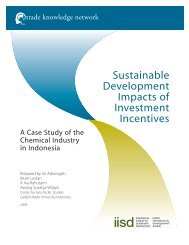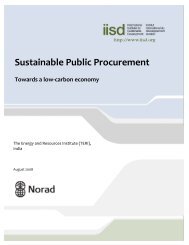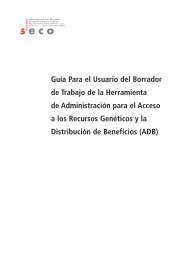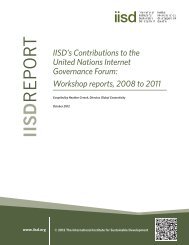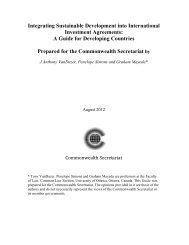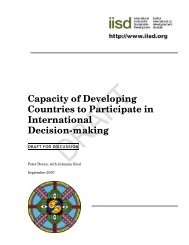Earthenterprise Tool Kit - International Institute for Sustainable ...
Earthenterprise Tool Kit - International Institute for Sustainable ...
Earthenterprise Tool Kit - International Institute for Sustainable ...
You also want an ePaper? Increase the reach of your titles
YUMPU automatically turns print PDFs into web optimized ePapers that Google loves.
EarthEnterprise <strong>Tool</strong> <strong>Kit</strong><br />
• The most responsive age group is young adults, many of whom are<br />
influenced by their children.<br />
• Women are a key target <strong>for</strong> greener products and often make purchases <strong>for</strong><br />
men.<br />
Background to statistical categories<br />
1. Income Index: ratio of median group income to median national income.<br />
Green consumers in the U.S. and Canada earn above average incomes.<br />
2. Median Age: The data <strong>for</strong> Canada suggests that younger adults are more<br />
likely to be green than older people. The data <strong>for</strong> the U.S. and Mexico are<br />
not very conclusive (although more detailed results from the Roper Poll and<br />
other surveys show that green sensibilities are strongest among U.S. adults<br />
aged 30-45). Note: Research also shows that children and teenagers are the<br />
most sensitive to green issues.<br />
3. Executive/Professionals: percentage of consumers in high skill, white collar<br />
professions. Professionals and executives tend to be greener consumers.<br />
4. College Graduates: The data generally show that the more educated the<br />
person, the more likely he or she is to be a green consumer.<br />
5. Female: The data show that women tend to be more green than men.<br />
Understanding the demographic basics about green consumers can help nongreen<br />
entrepreneurs explore the environmental market and home in on likely<br />
p ro s p e c t s . Those alre a dy in the business can better tailor outreach and<br />
communications to consumers.<br />
In the U. S., the age factor means a flourishing market as greener kids replace<br />
the less green elderly. Children and teens are generally much more concerned<br />
than adults about the environment and are more knowledgeable about green<br />
alternatives. Increasingly, they influence their parents’ purchasing decisions<br />
towards green and, more important, millions of them will reach adulthood and<br />
gain purchasing power in the next few years.<br />
At the opposite end of the age spectrum, Americans born be<strong>for</strong>e the end of<br />
World War II are the least green in consumer orientation. As they age, their<br />
share of consumer purchases will dwindle, and be replaced by consumers with<br />
a greener ethic.<br />
In Canada, children share very strong green concerns that influence their<br />
parents. Older people also tend to be relatively active green purchasers. The<br />
E nv i ronmental Monitor reports that green purc h a s i n g , “...does not va ry<br />
significantly among demographic and regional groups”.The Roper Poll, on the<br />
AVALANCHE MARKETS<br />
15




